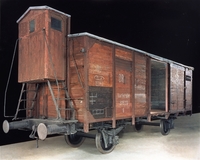Overview
- Brief Narrative
- Large metal chain with a hook on the end acquired with a railroad freight car and railroad rails from Poland in 1989.
- Geography
-
acquired:
Poland
- Credit Line
- United States Holocaust Memorial Museum Collection, Gift of the Institute of National Remembrance
Physical Details
- Classification
-
Tools and Equipment
- Category
-
Hardware
- Object Type
-
Chains (lsch)
- Genre/Form
- Chains.
- Physical Description
- Large, yellow painted, metal chain comprised of closed oblong links hooked end to end. The last link is an anchor shackle, a U-shaped link with a thick, ringed pin closing the open end. A large, curved, metal hook with a flared interior edge and a ringed base is attached to the last link. Much of the painted surface of the chain has worn off, exposing the dark metal underneath.
- Dimensions
- overall: Height: 3.000 inches (7.62 cm) | Width: 4.750 inches (12.065 cm) | Depth: 437.125 inches (1110.298 cm)
- Materials
- overall : metal, paint
Rights & Restrictions
- Conditions on Access
- No restrictions on access
- Conditions on Use
- No restrictions on use
Keywords & Subjects
- Geographic Name
- Poland.
Administrative Notes
- Legal Status
- Permanent Collection
- Provenance
- The chain was donated to the United States Holocaust Memorial Museum in 1991 by the Chief Commission for Investigating Nazi Crimes in Poland, Institute of National Remembrance.
- Record last modified:
- 2022-07-28 18:20:39
- This page:
- https://collections.ushmm.org/search/catalog/irn631240
Download & Licensing
In-Person Research
- By Appointment
- Request 21 Days in Advance of Visit
- Plan a Research Visit
- Request to See This Object
Contact Us
Also in Institute of National Remembrance collection
The collection consists of a rail car used to deport victims to concentration camps, railroad tracks and components that led to Treblinka killing center, and a chain.
Date: approximately 1907-1949

Double-door railroad freight car with brakeman’s cabin of the type used to transport victims throughout the Nazi camp system
Object
Association type 2 (A2), Gedeckter (G, covered) freight wagon owned by the Deutsche Reichsbahn (DR, German National Railway), one of several types used to transport victims through the Nazi camp system and to killing centers during the Holocaust. The car, numbered 31599, is a 15T (rated to carry 15 tons), equipped with a brakeman’s box, making it a Karlsruhe class wagon. The cars continued to be used after World War II, and as parts on the cars degraded, they were replaced with others from a variety of manufacturers. A2 railcars were produced from 1910-1927, and were originally used to transport goods that required protection from the elements. Deportation trains were ordered by telegram or telex, and gave the amount and type of cars needed. The actual trains were compiled at the stations from the cars available there. Before each transport left, the railway guard listed all cars by their identification numbers. Few of these lists survived, as they were not kept after a train had reached its destination. Jewish prisoners were then packed into railcars, approximately eighty people per car, and transported into the Nazi camp system, and eventually to killing centers in German-occupied Poland. During transport, prisoners were denied food and water, and many deportees died before the trains reached their destinations. Armed guards shot anyone trying to escape. The Reichsbahn charged a base rate of third class passenger fare for a deportee, children under ten traveled at half price and those under four traveled free, and special group rates were offered if at least four hundred people were in one shipment. Payment for transport was handled by the Reich Security Main Office headed by Adolf Eichmann.
Railroad rails, fishplates, bolts, nuts, and washers from railroad tracks leading to Treblinka death camp
Object
Railroad rails and components from railroad tracks that led to Treblinka killing center in German-occupied Poland. The individual rail segments were connected end to end with fasteners called fishplates (joint bars), which were bolted to internal holes in the rails to secure the tracks together and keep them from moving as trains passed over them. During the Holocaust, the Nazis used the European rail network to transport their victims into the camp system, and eventually to killing centers in German-occupied Poland. Deportation trains were ordered by telegram or telex, and gave the amount and type of cars needed. The actual trains were compiled at the stations from the cars available there. Before each transport left, the railway guard listed all cars by their identification numbers. Few of these lists survived, as they were not kept after a train had reached its destination. Jewish prisoners were packed into railcars, approximately eighty people per car, and were denied food and water. Many deportees died before the trains reached their destinations. Armed guards shot anyone trying to escape. Incoming trains bound for Treblinka first stopped at the Malkinia station. Twenty cars at a time were detached from the train and brought into the killing center. There, the victims were told they had arrived at a transit camp, ordered to disembark, and instructed to hand over their valuables. Between 870,000 and 925,000 Jews were killed at Treblinka, most of them delivered by train.



